1
On Monday February 1, 1943 workers from the Dominion Glass Company in Wallaceburg went on strike. A UAW-CIO poster, saved from the event, suggested that there was no other option: "This action has been taken due to intimidation of employees, by representatives of the Company; and only after all…peaceful methods had failed to bring a solution of our disputes with the Company." The employees picketed the streets outside the factory for a number of reasons: the right to choose the union that represented them, better working conditions, vacation and health benefits, higher wages, and for recognition as an "essential war industry." The men felt that the car lights made for army vehicles, submarine battery cases, ash trays, and beer bottles were all examples of "essential" items made at Dominion Glass.2
Dominion Glass employees, on strike, listening to a speakerCirca 1943
Wallaceburg, Ontario, Canada
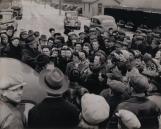 Credits:
Credits:Wallaceburg & District Museum
Photographer, Roy Mathany
3
A group of glass strikers posing with two O.P.P officersCirca 1943
Wallaceburg, Ontario, Canada
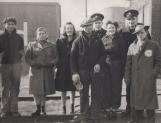 Credits:
Credits:Wallaceburg & District Museum
Photographer, Roy Mathany
4
At the end of February frustrations between the police and strikers escalated. Wallaceburg law enforcement had trouble keeping order and called in 150 O.P.P. officers for assistance. On several occasions the town's chief of police, Charles Worm, ordered his men to use tear gas and clubs on the crowds to disperse them. Thomas Sherwood, Chairman the local 251 UAW-CIO union, remarked on the violence used by police: "The only difference between conditions at Wallaceburg during the strike and those under Czarist Russia was the fact that the Russians called out the Cossacks to settle difficulties and we got the provincial police." Sherwood's comments, though extreme, highlight how brutal the violence was on occasion during the labour disagreements.In a report by the Windsor Daily Star on Tuesday, February 23, 1943, an interview was done with three people injured by police. A Mrs. Frank Timmerman recalled that a tear gas bomb exploded right next to her, filling her lungs, making it very difficult for her to move. She fell to the ground and was then struck in the legs and knee by riot sticks. She was not on strike. She only showed up to tell her husband company had arrived. Frank Sterling, a 63 year old employee, was struck on the head and shoulders, by police clubs. He said that he was not even near the picket line when this occurred. Perhaps the most illustrative was the account of Remi Van Hoover: "I was talking to a woman when all at once a policeman came from behind and hit me on the side of the head. I was not on the road to the gate. I didn't' hear anyone say move." In all of these reminiscences one sees a common trend. Police attacked innocent bystanders or people unable to defend themselves. The Windsor Daily Star exhibited a particular bias with this account. Other reports suggested that the police focused most of their attention on the strikers causing the problems. Furthermore, law enforcement officials were also hurt by picketers during the events that transpired. Injuries occurred on both sides. Though these accounts demonstrated that employees and innocent bystanders were beaten excessively it fails to recognize the brutality of the two fractions. Both the police and the strikers were responsible for a number of harmful acts.
The Chatham Daily News reported on February 11, 1943, that Rachel Van Snick was attacked by Alfonse Laffeber. Van Snick was walking home when Laffeber recognized her as one of his co-workers wives. He asked if her husband was currently working at the factory. She answered yes. He then grabbed her violently by the arm and threatened her. He wanted her husband to join the strikers and leave the plant immediately. She was terribly frightened and the incident was reported to police. Laffeber was later charged with assault. The Globe and Mail reported on a similar event a day earlier. On February 10, 1943, it was alleged that George Masefield, a 70 year old employee at the glass factory, was attacked on February 1. The incident occurred when he attempted to cross the picket line. He was hurt seriously by the transgression and was confined to bed rest for several days. These two incidents demonstrate that picketers were not entirely innocent during the strike. Both the police and employees of the Dominion Glass Company used excessive force to defend their causes.
5
A hoard of Dominion Glass employees on strikeCirca 1943
Wallaceburg, Ontario, Canada
 Credits:
Credits:Wallaceburg & District Museum
Roy Mathany, Photographer
6
Eddie Davies car going through the picket lineCirca 1943
Wallaceburg, Ontario, Canada
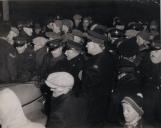 Credits:
Credits:Wallaceburg & District Museum
Photographer, Roy Mathany
7
Otto Young and two other Dominion Glass employees on strikeCirca 1943
Wallaceburg, Ontario, Canada
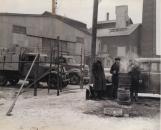 Credits:
Credits:Wallaceburg & District Museum
Photographer, Roy Mathany
8
Most war-time strikes in Canadian history have faced harsh criticism from nationalists. This strike was no exception. A Globe and Mail columnist wrote a number of inflammatory pieces that illustrated the harsh backlash for the Wallaceburg strike from Canadian conservatives. The title of the column was "You Bet I'm a Vet" and was written by M.A. Sanderson. He suggested, in a column from February 23, 1943, that any "labour legislation based on C.I.O. principals would place all workers, union funds, and all industry: "under the thumb" of Labour Racketeers and Gangsters." The C.I.O. was the major negotiating union that won the support of glass workers in Wallaceburg. When he asked himself in a later column, March 8, 1943, if he should apologize for these remarks he responded with inciting sarcasm. Sanderson wrote, "Yes I owe the C.I.O. Communists an apology, just as I owe an apology to Hitler and his Nazis for their inhuman treatment of Czech-Slovaks; the Poles; the Greeks; the Jews; and millions of others in blacked out Europe. Sanderson's column, demonstrated the feeling that all able bodied men and women should be supporting the war effort. A stall in any kind of war production because of a strike was considered unpatriotic in the least or treasonous at worst. His thoughts were indicative of what a number of Canadians thought during "the glass town strike".One of the causes of the strike that provoked the greatest unrest among employees was the unwillingness of the Dominion Glass Company to negotiate with the UAW-CIO. It was a particular matter of contention because they had been democratically elected by company workers to represent them. There was no legislation at the time of the strike that forced companies to negotiate with democratically elected unions in Ontario. The Wallaceburg strike changed this notion. Left wing politicians and some important Canadian figures supported the strike because of this cause. A Windsor Daily Star article from March 5, 1943, interviewed a number of people from the aforementioned group that highlights this perspective. Agnes McPhail sympathized with the Wallaceburg strikers' cause, "Labour should have a voice independent in everyway from management in choosing their bargaining agent." M.P., Arthur W. Roebuck, agreed with her sentiments and gave a similar statement: "Wise employers are not adverse to collective bargaining; the other kind should not be permitted to disrupt the community by arbitrary anti-social action." Finally, Dr. Salem Bland commented on the issue very clearly, "I am absolutely in sympathy with the Wallaceburg strikers. It is just another deplorable illustration which results from the absence of a clear, mandatory collective bargaining act." A short walkout in sympathy for the glass strikers was held at the Wallaceburg Brass & Iron Company, in addition to Schultz Die-Casting. These sentiments showed that the glass employees had the support of many other workers and citizens in the community.
9
Dominion Glass Company employees on strikeCirca 1943
Wallaceburg, Ontario, Canada
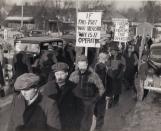 Credits:
Credits:Wallaceburg & District Museum
Photographer, Roy Mathany
10
Martha Modde and Susie Notschael, packing room workers on strikeCirca 1943
Wallaceburg, Ontario, Canada
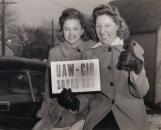 Credits:
Credits:Wallaceburg & District Museum
Roy Mathany, Photographer
11
Peter Heenan, Andrew Gilhuly, and Geo Burt discuss the wartime glass strike situationCirca 1943
Wallaceburg, Ontario, Canada
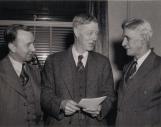 Credits:
Credits:Wallaceburg & District Museum
Photographer, Roy Mathany